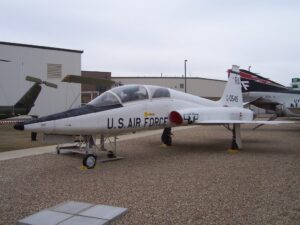The T-38A Talon came to our Museum as a permanent loan at the direction of the National Museum of the United States Air Force at Wright-Patterson Air Force Base, Dayton, OH in 1993. The last duty station, though, was at Chanute Technical Center (Air Training Command), at Chanute AFB, Rantoul, IL. It was moved from Chanute AFB to the our museum in 1993.
Interactive Display
Click on a colored PIN to display additional information (text, video, recording, images).
This feature is an extra benefit as you walk around the display in our Airpark.
WIFI is provided for your mobile device. A network QR code or name/password is provided at the desk.
PINS – in development
PINS – in development
PINS – in development
PINS – in development
Videos of Interest
Video #1: Intrepid Museum – Aircraft of the Month – T-38 Talon Run Time (0:02:41)
Video #2: T-38 Talon Walkaround Run Time (0:08:41)
Video #3: INSTRUMENT FLIGHT IN THE T-38A TALON TRAINING AIRCRAFT U.S. AIR FORCE FILM Run Time (0:29:31)
Video #4: Military T-38 Jet Flight Helmet Cam Full Comms Run Time (1:00:46)
History
The T-38 was designed in the mid 1950s as the trainer variant of a lightweight fighter project by the Northrop Corporation (today part of Northrop Grumman). Although the United States Air Force had no need for a small fighter at the time, it became interested in the trainer as a replacement for the Lockheed T-33s it was then using in this role. The first of three prototypes (designated YT-38) flew on March 10 1959. The type was quickly adopted and the first production examples were delivered in 1961, officially entering service on March 17 that year. When production ended in 1972, 1,187 T-38s had been built. Since its introduction, it is estimated that some 50,000 military pilots have trained in this aircraft.
The instructor and student sit in tandem on rocket-powered ejection seats in a pressurized, air-conditioned cockpit. Critical components are waist high and can be easily reached by maintenance crews.
The T-38A needs as little as 2,300 feet of runway to take off and can climb from sea level to nearly 30,000 feet in one minute. Its nimble performance earned it the nickname “White Rocket” – in 1962, T-38s set four time to climb records.
The Talon first flew in 1959. More than 1,100 were delivered to the Air Force between 1961 and 1972 when production ended. The Pacer Classic was a program designed to extend the structural life of the T-38 to 2020. Future major modifications to the T-38 avionics systems will result in all Talons being redesignated as T-38C models.
The National Aeronautics and Space Administration (NASA) uses T-38A aircraft as trainers for astronauts and as observers and chase planes on programs such as the space shuttle.
ROLE: Trainer
Crew: Two
Bureau Number: 60-0549
SPECIFICATIONS
Engine: Two General Electric after burning GEJ85-GE-5, thrust of 3,850 pounds
Wing Span: 25 feet 3 inches
Length: 46 feet 4 inches
Height: 12 feet 10 inches
Empty Weight: 7,164 pounds
Maximum speed: Mach 1.3 or 858 miles per hour at 36,000 feet
Ceiling: 53,600 feet
Previous Duty Stations
T-38A Talon
Bureau Number :60-549
| 29 Mar 1961: | Entered into USAF inventory. |
| Apr 1961 | 3510th Flying Training Command Randolph AFB TX |
| May 1962: | 3510th Maintenance Support Group Randolph AFB TX |
| Dec 1967: | 3250th Flying Training Squadron Tyndall AFB FL |
| Jul 1971: | 3525th Pilot Training Wing Williams AFB AZ |
| Nov 1971: | Military Aircraft Storage amd Disposition Center Davis -Monthan AFB AZ |
| Feb 1974: | 3345th Maintenance Support Group Chanute AFB (to GT-38 A, ground instructional airframe.) |
| Oct 1975: | Chanute Technical Center Chanute AFB |
| May 1993: | Transfered to Prairie Aviation Musuem |

